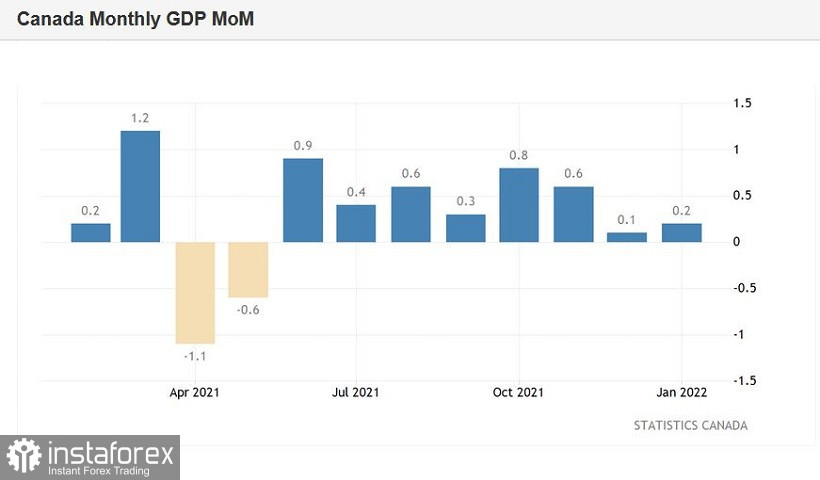On Wednesday, the CAD/USD pair approached a multi-month low of 1.2430. The last time the pair was at such lows was in November 2021. Then the pair tried to break through the 23rd and the 22nd patterns. However, a downward movement turned out to be short-lived. After sliding down to the yearly low, the loonie rebounded to the range of 1.2470-1.2530. Now, it is hovering in this range. To cement a bearish bias, traders need fundamental factors. Currently, they are very contradictory. Therefore, market participants are now forced to take a cautious approach. So, this is the main reason why the pair is now trading flat, formed within the 60- pip range.

The USD/CAD pair has been trading within a downward trend for some time. On the weekly chart, the Canadian dollar has strengthened by 450 pips over the past three weeks. Such a rise was triggered by several fundamental factors at once. Firstly, it managed to gain steam amid the hawkish stance of the Bank of Canada. At the March meeting, the Bank of Canada raised the key rate by 25 basis points. It also announced it would further tighten monetary policy. Secondly, crucial macroeconomic reports that were published in the previous month boosted the Canadian dollar. Only the latest GDP data undermined a steady rise. Inflation and the labor market reports also bolstered its growth. The consumer price index jumped to 1.0% on a monthly basis, logging the strongest rise since 2013. The CPI rose to 5.7% in annual terms, notching the highest level since 1991. Core inflation climbed to 4.8%, hitting a yearly high. As for the labor market, the unemployment rate dropped to 5.5%, a low of February 2021. The employment level in the country increased by 336,000 versus the forecast reading of 120,000.
The loonie resumed a sharp decline due to such positive reports. Moreover, there are rumors that the Canadian regulator may raise the interest rate by 50 basis points at once at its next meeting scheduled for April 13. In my opinion, such a scenario is unlikely. However, bears were able to push the pair to the multi-month low amid such speculation.
However, by the end of this week, the bears have lost steam. The fact is that quite contradictory data on Canadian GDP growth was published yesterday. On a monthly basis, GDP rose by 0.2%, which was in line with the forecasts. In annual terms, the figure advanced to 3.5%. As a result, it escaped the red zone. Economists had expected the indicator to total 3.6%. The report underlined that structure of the expansion was recorded primarily in the manufacturing sector. The construction sector has also demonstrated a positive dynamic. It is steadily recovering after the coronavirus crisis. New home constructions jumped by 4.3%, showing the strongest increase since March last year. The indicator grew after a two-month decline. The service sector, on the contrary, dropped. The February reading was rather disappointing. Hotel services, catering, entertainment, and recreation industries incurred the biggest losses. As the result, the services sector notched the largest monthly drop since the first wave of the coronavirus crisis in April 2020.
Many analysts believe that the Canadian economy will slow down in the first half of the year due to geopolitical woes and supply chain disruptions.

Thus, the Canadian dollar halted its decrease following the release of GDP data although this report was not negative. Nevertheless, the bears retreated in anticipation of new drivers. In the medium term, the trajectory of the loonie will depend on the results of the US Nonfarm Payrolls report. If gobs data is upbeat, USD/CAD may edge higher. If the NFP report is worse than expected, the bears will take the upper hand, pushing the price to the 24th pattern. The pair is unlikely to break out of the range of 1.2400-1.2530 in the medium term. However, the movement within this range will depend on NFP data and market reaction to it. If Us jobs data is mixed, it is hard to predict what to expect from the price. To this end, it is recommended to make trading decisions after the publication of today's NFP data.
 English
English 
 Русский
Русский Bahasa Indonesia
Bahasa Indonesia Bahasa Malay
Bahasa Malay ไทย
ไทย Español
Español Deutsch
Deutsch Български
Български Français
Français Tiếng Việt
Tiếng Việt 中文
中文 বাংলা
বাংলা हिन्दी
हिन्दी Čeština
Čeština Українська
Українська Română
Română

